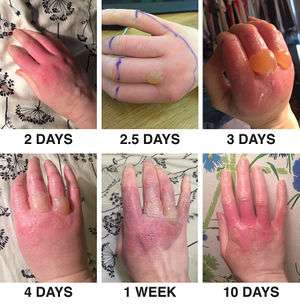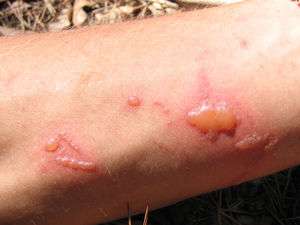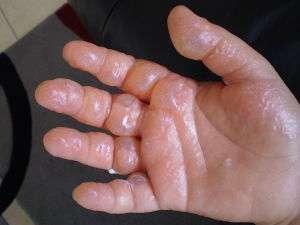Phytophotodermatitis
Background
- The result of chemicals in certain foods reacting with sunlight to cause an aggrevated "sun-burn" like rash
Common Causative Agents[1]
- Celery
- Parsnip
- Fennel
- Lime
- Carrot
- Mustard
- Parley
- Dill
- Grapefruit
- Lemon
- Fig
- St. John's wort
Clinical Features[2]

Phytophotodermatitis caused by lime

Classic phytophotodermatitis

Severe phytophotodermatitis
- Bizarre, linear streaking rash that can be painful or burning
- Bullae and vesicles
- Often in a "dripping" pattern or with hand-prints
- Acute phase 3-5 days, may then progress to hyperpigmentation for months
Differential Diagnosis
Vesiculobullous rashes
Febrile
- Diffuse distribution
- Varicella
- Smallpox
- Disseminated gonococcal disease
- DIC
- Purpural fulminans
- Localized distribution
Afebrile
- Diffuse distribution
- Bullous pemphigoid
- Drug-Induced bullous disorders
- Pemphigus vulgaris
- Phytophotodermatitis
- Erythema multiforme major
- Bullous impetigo
- Localized distribution
Evaluation
- Clinical diagnosis
Management
- Topical steroids (e.g. topical triamcinolone)[3]
Disposition
- Outpatient
See Also
External Links
References
- Raam et al. "Phytophotodermatitis: The other lime disease." Annals of EM. April 2016. 67(4):554-556
- Raam et al. "Phytophotodermatitis: The other lime disease." Annals of EM. April 2016. 67(4):554-556
- Raam et al. "Phytophotodermatitis: The other lime disease." Annals of EM. April 2016. 67(4):554-556
This article is issued from
Wikem.
The text is licensed under Creative
Commons - Attribution - Sharealike.
Additional terms may apply for the media files.